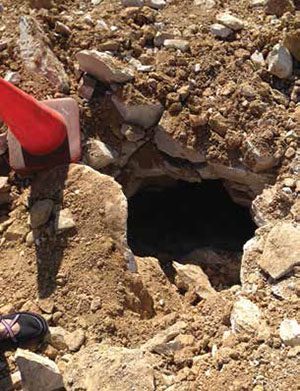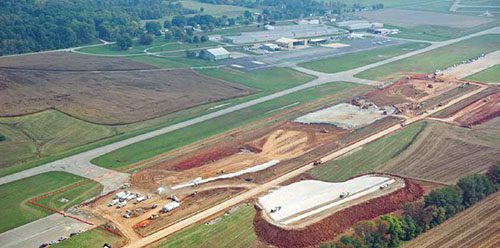 Catastrophic sinkhole incidents are horrific events that take victims by surprise and leave onlookers shaking their heads in disbelief. From the Florida man who was killed when his bedroom floor collapsed beneath him last year to eight cars being swallowed from the National Corvette Museum earlier this year, they're all hard to fathom.
Catastrophic sinkhole incidents are horrific events that take victims by surprise and leave onlookers shaking their heads in disbelief. From the Florida man who was killed when his bedroom floor collapsed beneath him last year to eight cars being swallowed from the National Corvette Museum earlier this year, they're all hard to fathom.
Last fall, Monroe County Airport (BMG) in Bloomington, IN, completed an $11 million project to increase runway safety and ensure that the Indiana airfield would not become the subject of the next sinkhole disaster. Armed with carefully engineered plans, crews literally worked around the clock to repair an area near BMG's main runway that was 260 feet wide and up to 30 feet deep. After mending the damaged areas using a geogrid material, workers filled the holes with rock, geotechnical fabric and soil.
When they were finished, you could practically hear Airport Director Bruce Payton's blood pressure drop.
|
factsfigures Project: Sinkhole Repair Location: Monroe County (IN) Airport Cost: $11 million Funding: $9.8 million from FAA; $1.2 million from Monroe County & IN Dept. of Transportation Scope: 3 Sinkholes Along Main Runway Project Engineer: Hanson Professional Services Contractors: Crider & Crider; Dave O'Mara Contractor Key Benefit: Increased airfield safety |
Statistically speaking, sinkholes are more common than many people assume. According to geologists, Florida alone has more than 19,000. Any area characterized by karst topography – land formed from water-soluble rock such as limestone and carbonate rock – is at risk for sinkholes. While most don't prove tragic, they are unpredictable and contain the potential for dire consequences if not found and addressed.
There's a What Near Your Runway?
As shocking as the term "airfield sinkhole" sounds, Payton wasn't completely surprised when one was detected near BMG's main runway in the early 1990s. The general landscape around Bloomington, IN, is dominated by karst topography; and he knew that crews had cut into a "cave" when building the runway back in 1966.
Initial tests showed no imminent signs that the sinkhole would grow; and the airport stabilized the site with cement fill. Payton and other officials, however, knew that the fill was not a permanent fix.

Mother Nature reminded them of the ongoing issue throughout the following years. Between 1996 and 2013, Monroe County experienced 73 hailstorms and six floods, putting more stress on the airport's already unstable sinkhole area. By May 2011, after storms dropped more than 11 inches of rain in the area, three sinkholes were identified in the runway safety area and along the pavement of the airport's main 6,500-foot runway.
"One was encroaching on the asphalt edge," recalls Payton. Based on years of rainwater erosion, it was critical to determine the stability of the pavement.
Payton requested and obtained $50,000 in emergency funds from the construction account of the county-owned airport and hired Hanson Professional Services to manage the preliminary investigation. In addition to having knowledge about the airport's karst terrain from previous projects, Hanson engineers had access to specialized equipment to assess site conditions, notes Payton.
The engineering and planning firm's immediate objective was to begin assessing whether the runway was viable for continued use. Later, team members performed an environmental assessment to help guide the project's strategy.

Throughout the process, Hanson leveraged several different testing technologies and cross-referenced their results. Initially, the Indiana Department of Transportation used a falling-weight deflectometer and ground-penetrating radar to gauge the size of the sinkholes. In addition, Payton invited geology experts from Indiana University to assess the stone and other airfield conditions.
"Electrical resistivity testing provided the best approximation of the subsurface voids," notes Hanson Project Manager Joe Worley. "Ground penetrating radar is inconclusive in clay soils."
Hanson's team analyzed the data and developed seven different scenarios based on a menu of risk assessments and potential responses. Worley describes the option that was selected as "environmentally friendly mitigation that would bridge over the karst area, yet continue to allow ground water to maintain its natural flow."
With the project strategy selected, Hanson applied for FAA funding on the airport's behalf. In the meantime, the runway was deemed usable if the surface holes were temporarily secured with coarse aggregate and covered with load-bearing steel plates. Not all charter services felt comfortable with the temporary fix, though; and BMG lost revenue while waiting for funding.
Ultimately, FAA contributed $9.8 million to the project, and the county and Indiana Department of Transportation funded the remaining $1.2 million.
The Big Fix
Bloomington contractor Crider & Crider and Dave O'Mara Contractor, which has an office in Bloomington, were awarded the contract for airfield repairs. While the companies were chosen based on their bids, Payton stresses how crucial it was having local businesses work on the project. In addition to their familiarity with karst topography, the contractors were available to begin immediately – a substantial advantage, given the project's 68-day project window.
"We required all involved to meet the deadline," Payton relates. The contractors, testing services and Hanson consequently had to work 24 hours a day, seven days a week.
Excavation began on Sept. 16, 2013 – the very day that the Monroe County Board of Aviation Commissioners gave notice to proceed, notes Payton. With the runway closed, workers began by removing nearly 300,000 cubic yards of earth from the suspect area. Next, crews repaired the hole using a geogrid material topped with layers of various gradations of large and small stones, a geotechnical fabric and soil.

The project lost two days to rain, and the main runway reopened Nov. 19, 2013 (precisely two days behind schedule.)
The airport and Hanson both consider the project a big environmental success. The repair strategies used maintain the natural flow of ground water through bedrock cracks as much as possible, explains Payton. Additionally, asphalt from the excavated material was milled and earmarked for recycling into future pavements; and all new stone used on the project was provided by a quarry less than a mile away.
On the negative side, airport tenants felt an economic squeeze during the construction phase of the project. With the airport's main runway closed, Cook Aviation had to temporarily move its larger aircraft to Indianapolis International Airport. BMG Aviation, the privately owned fixed-base operator that provides fuel and maintenance for the field, also took a hit. The airport's bottom line also suffered from decreased flowage fees.
Given the revenue losses, Payton was especially glad that area contractors won many of the contracts for the project. Hiring local companies helped mitigate the net effect on Bloomington's overall economy.
Payton was also pleased that the repairs were made before any more moisture soaked into the airfield. Just two weeks after the runway re-opened, the area received its first snowfall. "That snow stayed on the ground," he recalls, "and winter continued with record snowfall for this portion of Indiana."


